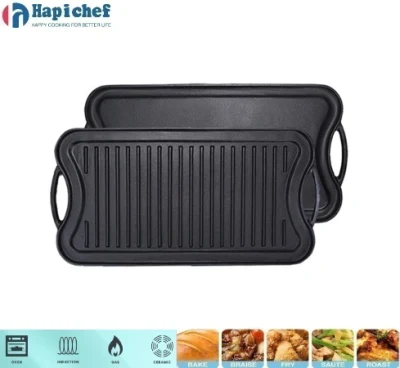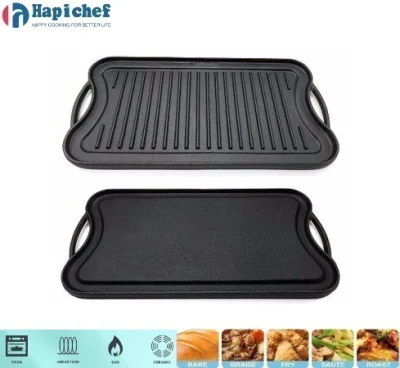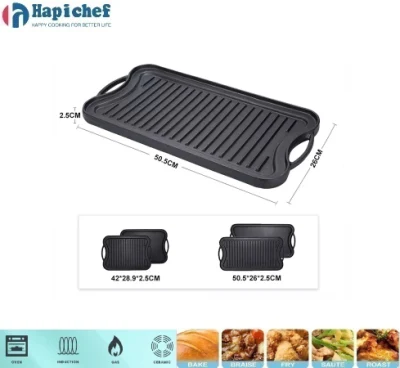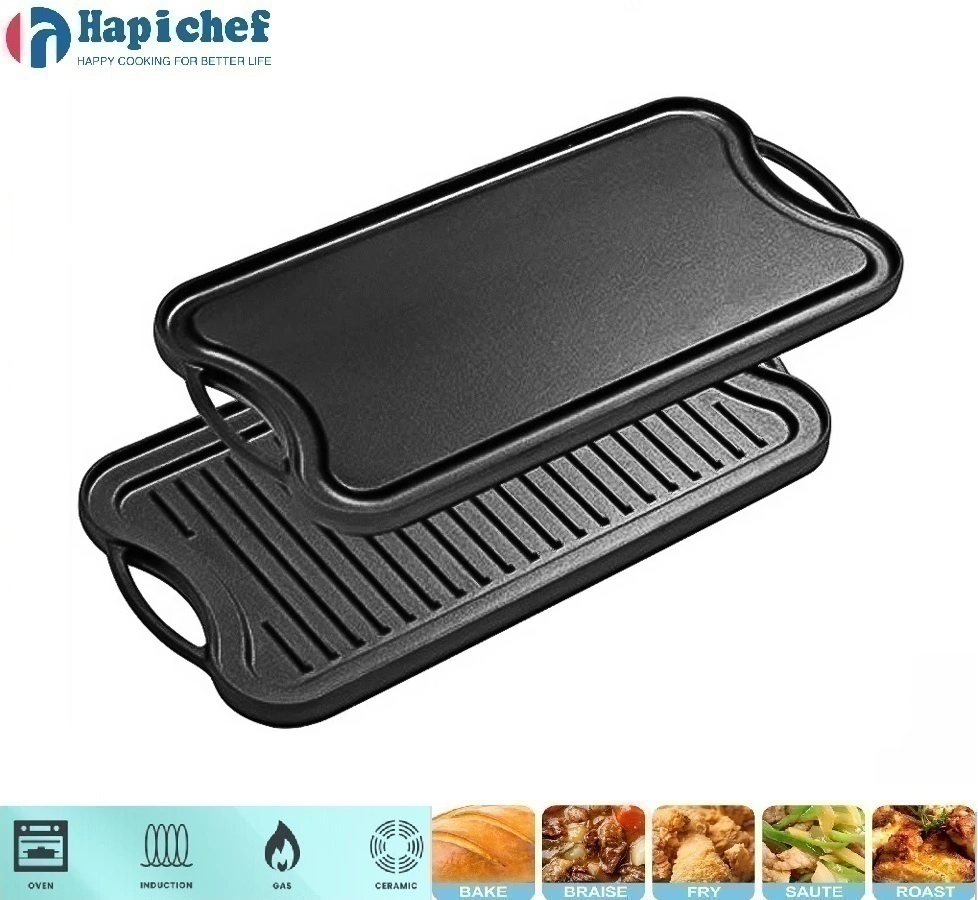Premium Cast Iron Griddle for Sale | BBQ Grill & Stove Top
Navigating the Market: Current Trends in Commercial Cast Iron Griddles
The demand for robust and versatile cooking surfaces in the B2B sector continues to grow, with a notable resurgence in the popularity of cast iron cookware. Businesses, from high-volume catering operations to specialty food trucks, are actively seeking a reliable cast iron griddle for sale that offers superior thermal performance and exceptional durability. This trend is driven by several factors, including the push for authentic cooking experiences, the cost-effectiveness of long-lasting equipment, and the increasing versatility required in modern commercial kitchens.
Industry data indicates a steady year-over-year growth in the commercial cast iron cookware segment, projected to reach a market valuation of over $300 million by 2028, with a compound annual growth rate (CAGR) exceeding 4%. This growth is particularly pronounced in the outdoor and live-cooking sectors, where equipment must withstand rigorous conditions while delivering consistent results. The emphasis on multi-functional tools, such as reversible griddle/grill plates, underscores the market's need for efficiency and adaptability. Furthermore, an increasing appreciation for traditional cooking methods that impart unique flavors, such as the distinct sear achieved on a barbecue griddle cast iron, contributes significantly to this upward trajectory.
Beyond new acquisitions, there's a niche market for specialized and even antique cast iron griddle for sale pieces, often sought by establishments aiming for a specific aesthetic or a connection to culinary heritage. However, the primary demand remains for newly manufactured, high-performance units that meet stringent modern food safety and operational standards.

Precision Engineering: The Manufacturing Process of a Cast Iron Griddle
The creation of a high-quality cast iron griddle for sale is a testament to metallurgy and precision manufacturing. The process typically involves several critical stages, each contributing to the final product's performance, durability, and safety.
1. Raw Material Sourcing & Melting
The foundation of any superior cast iron product lies in its raw materials. Manufacturers typically utilize high-grade pig iron, steel scrap, and precise additions of carbon, silicon, and manganese. These elements are carefully measured and melted in induction furnaces, reaching temperatures well over 1,400°C (2,550°F). The precise control of the melt's chemical composition is crucial for achieving the desired metallurgical properties, such as hardness, strength, and thermal conductivity. For cookware, a grey iron composition, rich in carbon (typically 2.5-4.0%) and silicon (1.0-3.0%), is preferred, as it forms graphite flakes upon cooling, contributing to cast iron's characteristic thermal stability and machinability.
2. Mold Creation (Sand Casting)
The most common method for shaping cast iron griddles is sand casting. A detailed pattern, representing the final product, is used to create a cavity in specially prepared sand molds. For reversible griddles, the complexity increases, requiring meticulous pattern design to ensure both the flat griddle surface and the raised grill ribs are perfectly formed. The sand used is often a blend of silica sand, clay (bentonite), and water, which provides sufficient strength to withstand the molten metal while allowing gases to escape during pouring.
3. Pouring & Solidification
Once the molds are ready, the molten iron is carefully poured into the mold cavities. This stage requires precise temperature control and pouring speed to prevent defects such as cold shuts or porosity. As the iron cools within the sand mold, it solidifies, taking on the shape of the griddle. The controlled cooling rate is vital to influence the microstructure of the cast iron, optimizing its physical properties.
4. Shakeout & Fettling
After solidification, the castings are removed from the sand molds in a process known as shakeout. The sand is then recycled. The raw castings will still have risers (channels for molten metal) and flash (excess material at mold part lines) attached. Fettling involves grinding, chipping, or shot blasting to remove these imperfections, leaving a clean, rough casting.
5. Machining & Surface Preparation
For a premium bbq grill cast iron griddle, precision machining is often employed to ensure flatness, especially for the cooking surface, and to refine edges and handle attachments. This is typically done using CNC (Computer Numerical Control) machines, guaranteeing tight tolerances and a consistently smooth finish. After machining, the griddle undergoes thorough cleaning and surface preparation, often involving abrasive blasting, to create an optimal surface for seasoning.
6. Pre-Seasoning
A critical step for cookware, pre-seasoning involves applying a thin layer of food-grade vegetable oil (such as soybean or flaxseed oil) and baking the griddle at high temperatures. This process polymerizes the oil, creating a durable, natural non-stick surface (patina) and providing initial rust protection. A properly pre-seasoned griddle ensures immediate usability and simplifies maintenance for end-users.
7. Quality Control & Testing
Throughout the entire manufacturing process, rigorous quality control measures are implemented. This includes:
- Material Composition Analysis: Spectrographic analysis to verify alloy elements.
- Dimensional Inspection: Ensuring adherence to design specifications.
- Surface Finish Evaluation: Checking for defects and consistency.
- Food Safety Compliance: Adherence to standards like FDA (Food and Drug Administration) for food contact materials and NSF International for commercial food equipment safety and sanitation.
- Performance Testing: Often involving initial heat distribution and non-stick tests.

Technical Specifications and Performance Metrics
When evaluating a cast iron griddle for sale, understanding its technical specifications is paramount for B2B decision-makers. These parameters dictate performance, efficiency, and suitability for various commercial applications.
Key Material & Performance Data:
- Material Grade: Typically ASTM A48 Class 20 or 30 grey cast iron, chosen for its excellent thermal properties and damping capacity.
- Thermal Conductivity: Approximately 50-60 W/m·K. While lower than aluminum, cast iron's high thermal mass allows for exceptional heat retention and even heat distribution once preheated.
- Specific Heat Capacity: Around 0.46 kJ/kg·K, contributing to its ability to store and radiate heat consistently.
- Operating Temperature Range: Capable of handling extreme temperatures, from stovetop use to open flames, typically up to 300°C (572°F) and beyond without deformation.
- Service Life: With proper care and seasoning, commercial cast iron griddles can last for decades, often exceeding 50 years, making them a highly sustainable investment.
- Surface Hardness: Brinell Hardness Number (BHN) typically ranges from 160-220, offering excellent resistance to scratching and abrasion from utensils.
Product Specification Table: BBQ Outdoor Cookware Cast Iron Grill Pan Reversible Griddle
| Feature | Specification | Benefit to B2B Users |
|---|---|---|
| Product Name | BBQ Outdoor Cookware Cast Iron Grill Pan Reversible Griddle | Clear identification for procurement. |
| Material | Premium Grey Cast Iron (ASTM A48 Class 30 equivalent) | Exceptional heat retention and distribution, long-term durability. |
| Cooking Surface | Reversible (Smooth Griddle / Ribbed Grill) | Versatility for various cooking styles (searing, frying, grilling), maximizes equipment utility. |
| Dimensions (Approx.) | 19.7" L x 9.8" W (50cm x 25cm) | Optimized size for standard BBQ grills and stovetops; ample cooking area. |
| Weight (Approx.) | 9.9 lbs (4.5 kg) | Substantial mass for stable heat retention; manageable for commercial handling. |
| Pre-seasoning | Vegetable Oil (Ready-to-use) | Immediate operational readiness; natural non-stick surface, rust protection. |
| Handle Design | Integrated side handles | Secure handling and portability, even when hot (with protective gear). |
| Certifications | FDA compliant, ISO 9001 manufacturing standards | Assurance of food safety, quality management, and regulatory compliance. |

Diverse Application Scenarios in Commercial Operations
The versatility of a premium bbq grill plate cast iron makes it indispensable across a spectrum of B2B applications. Its robust construction and superior thermal properties enable its use in environments demanding consistent performance and durability.
Target Industries and Use Cases:
- Hospitality Sector (Restaurants, Hotels, Resorts): Ideal for breakfast service (pancakes, bacon, eggs), searing meats and vegetables, or creating signature grilled items. The ability to move from stovetop to oven to outdoor grill offers unparalleled flexibility.
- Catering Services & Event Management: Essential for on-site cooking demonstrations, large-scale outdoor events, and mobile kitchen setups. Its robust nature withstands transport and varied cooking conditions. For instance, a caterer preparing a rustic themed wedding menu might seek an antique cast iron griddle for sale feel with modern performance.
- Food Trucks & Mobile Vendors: Compact yet powerful cooking surface for high-volume, quick-service food preparation, from gourmet burgers to specialized street food. Its even heat distribution is crucial for consistent product quality.
- Culinary Schools & Educational Institutions: Used for teaching fundamental cooking techniques involving searing, grilling, and griddling due to its reliable performance and long lifespan, providing students with authentic experience.
- Specialty Food Production: Businesses focused on specific items like flatbreads, tortillas, or specific grilled pastries benefit from the consistent, high heat a cast iron griddle provides, often reducing cook times and improving product texture.
- Outdoor Recreation Retailers/Rental: For businesses selling or renting outdoor cooking equipment, offering a durable bbq grill plate cast iron enhances their product lineup, appealing to serious campers, tailgaters, and outdoor enthusiasts.
In these diverse scenarios, the advantages of energy saving and corrosion resistance manifest as enhanced operational efficiency and reduced long-term maintenance costs. Cast iron’s superior thermal mass allows it to retain heat for longer, minimizing energy fluctuations and providing a more stable cooking temperature compared to thinner materials. The well-maintained seasoning layer offers a natural form of corrosion resistance, critical in high-humidity or outdoor cooking environments, further extending the product's lifespan.

Unparalleled Technical Advantages of Cast Iron Griddles
The enduring popularity of cast iron griddles in professional settings is not merely a matter of tradition; it is rooted in distinct technical advantages that deliver tangible benefits to B2B operations.
- Exceptional Thermal Mass & Heat Retention: Cast iron possesses a high thermal mass, meaning it absorbs and stores a significant amount of heat energy. Once preheated, it maintains a remarkably consistent temperature across its entire surface, even when cold food items are introduced. This prevents temperature drops that are common with thinner cookware, leading to superior searing, browning, and consistent cooking results, crucial for high-volume commercial use. This also translates to energy efficiency over time, as less energy is needed to maintain operating temperatures.
- Uniform Heat Distribution: While cast iron's thermal conductivity is not as high as copper or aluminum, its substantial thickness ensures that heat spreads evenly throughout the cooking surface. This eliminates hot spots, preventing unevenly cooked food and reducing waste, which is a key advantage for any professional establishment utilizing a cast iron griddle for sale.
- Natural Non-Stick Properties (with Seasoning): A well-seasoned cast iron griddle develops a natural, food-safe non-stick surface through the polymerization of oils. This patina improves with every use, reducing the need for excessive cooking fats and making cleaning easier. Unlike synthetic non-stick coatings, cast iron's surface is extremely durable and can be restored if damaged, offering a significantly longer lifespan.
- Durability & Longevity: Cast iron is virtually indestructible under normal use conditions. It resists warping, denting, and scratching, making it ideal for the demanding environment of commercial kitchens or outdoor catering. Its ability to last for generations makes it a highly sustainable and cost-effective investment, dramatically lowering the total cost of ownership compared to frequently replaced alternatives.
- Versatility Across Heat Sources: A cast iron griddle can be used on almost any heat source: gas stovetops, electric ranges, induction cooktops (due to its ferrous nature), ovens, grills, and even open campfires. This adaptability is invaluable for businesses operating across diverse settings, from indoor restaurants to outdoor events and catering.
- Enhanced Flavor Profile: The sustained, even heat and the unique surface of cast iron contribute to superior caramelization and the Maillard reaction, developing richer flavors and better crusts on foods. This distinct culinary advantage is often sought after in gourmet and specialty food establishments using a barbecue griddle cast iron.

Vendor Comparison: Choosing Your Cast Iron Griddle Supplier
When sourcing a cast iron griddle for sale, B2B buyers must look beyond the initial price point. A comprehensive vendor comparison considers product quality, material integrity, manufacturing standards, customization capabilities, and post-sales support.
Comparison Table: Commercial Cast Iron Griddle Vendors
| Feature/Criterion | Hapichef Cookware (Example) | Generic Competitor A | Generic Competitor B |
|---|---|---|---|
| Material Quality | Premium Grey Cast Iron (ASTM A48 Class 30 equivalent), high carbon/silicon content for superior thermal properties. | Standard commercial grade cast iron; material composition may vary. | Economical grade cast iron; potentially lower purity leading to brittleness. |
| Manufacturing Process | Precision Sand Casting, CNC Machining for flatness, controlled annealing. ISO 9001 certified. | Standard sand casting, minimal machining. ISO certification not always guaranteed. | Basic casting methods, often with less finishing, potential for surface irregularities. |
| Pre-seasoning Quality | Multi-layer, factory pre-seasoned with food-grade vegetable oil; immediate non-stick properties. | Single-layer seasoning or requires significant user seasoning prior to first use. | Often unseasoned or lightly oiled, demanding extensive user preparation. |
| Design Features | Reversible grill/griddle, integrated ergonomic handles, optimized grease channels. | Single-sided or basic reversible; rudimentary handles; less attention to functional design. | Basic flat griddle; no advanced features or ergonomic considerations. |
| Certifications | FDA compliant, ISO 9001. Ensures food safety and quality management. | May have basic food-safe declarations; limited third-party certifications. | Often lacks explicit certifications, relying on general material safety. |
| Customization Options | Available for bulk orders (size, branding, specialized coatings for industrial applications). | Limited customization, usually only for very large orders. | No customization offered. |
| Warranty & Support | Comprehensive warranty, dedicated B2B customer support, detailed care guides. | Standard limited warranty, general customer service. | Basic or no explicit warranty; self-service support. |

Customized Solutions for Specialized B2B Requirements
While standard off-the-shelf options meet many needs, discerning B2B clients often require bespoke solutions when looking for a cast iron griddle for sale. Customization ensures optimal integration with existing equipment, specific culinary demands, or unique branding strategies.
Leading manufacturers understand that a one-size-fits-all approach is insufficient for advanced commercial operations. Customized cast iron griddles can address:
- Specific Dimensions and Fit: Tailoring griddle sizes to perfectly match custom stoves, outdoor grills, or specialized cooking stations, minimizing gaps and maximizing cooking surface area.
- Unique Surface Designs: Beyond the standard smooth griddle and ribbed grill, custom patterns, branding logos, or specialized texture profiles can be integrated into the casting for signature dishes or brand promotion.
- Handle Configurations: Custom handle designs, including integrated, removable, or specific ergonomic considerations for high-frequency use or integration with automated systems.
- Material Enhancements: For extremely specialized industrial food preparation, slight alterations in the cast iron alloy could be explored to enhance specific properties like further corrosion resistance or higher temperature tolerance.
- Branding and Packaging: Private labeling, custom engraving, or specialized packaging for resellers or promotional giveaways, reinforcing brand identity.
Engaging with a manufacturer that offers robust design and engineering support is crucial for successful customization projects. This ensures that technical feasibility, material properties, and operational requirements are thoroughly vetted, resulting in a product that not only meets but exceeds specific performance expectations.
Application Case Studies: Real-World Impact
The practical benefits of a high-quality bbq grill cast iron griddle are best illustrated through real-world applications demonstrating improved efficiency, enhanced product quality, and long-term cost savings.
Case Study 1: High-Volume Breakfast Service at a Boutique Hotel Chain
A regional boutique hotel chain faced challenges in providing consistent, high-quality breakfast items (pancakes, eggs, bacon) during peak hours. Their existing stainless steel griddles suffered from uneven heating and significant temperature drops, leading to inconsistent cooking and increased wait times. After investing in a fleet of Hapichef's reversible cast iron griddles, they observed:
- 30% Reduction in Cooking Time: Due to superior heat retention and even distribution, dishes cooked faster and more consistently.
- Improved Food Quality: Uniform golden-brown pancakes and perfectly crispy bacon, enhancing guest satisfaction scores for breakfast service by 15%.
- Reduced Energy Consumption: The high thermal mass required less continuous energy input to maintain cooking temperatures, resulting in an estimated 10% reduction in utility costs for the cooking station.
Case Study 2: Outdoor Catering for Large-Scale Events
A prominent outdoor catering company specialized in corporate events and festivals. They needed portable, durable, and highly efficient cooking surfaces capable of handling diverse menus from grilled sliders to stir-fried vegetables. Their previous aluminum griddles warped under intense heat and scratched easily. By switching to Hapichef's robust bbq grill plate cast iron units, they experienced:
- Zero Equipment Failure: Griddles withstood extreme heat from propane burners and heavy-duty spatulas without warping or significant wear over a full season of events.
- Enhanced Menu Flexibility: The reversible design allowed quick transitions between grilling steaks and griddling vegetables or flatbreads, streamlining operations.
- Positive Customer Feedback: Clients consistently praised the quality of grilled items, noting the perfect sear and authentic flavor, directly attributable to the superior performance of the cast iron.

Frequently Asked Questions (FAQ)
Q: What is the ideal way to maintain the seasoning on a commercial cast iron griddle?
A: Regular seasoning is key. After each use, clean the griddle while it's still warm (avoid harsh soaps), dry thoroughly, and apply a thin layer of cooking oil (e.g., flaxseed, grapeseed, or vegetable oil) using a paper towel. Heat the griddle slightly until it just begins to smoke, then turn off the heat and let it cool. This process maintains the natural non-stick surface and prevents rust.
Q: Can these griddles be used on induction cooktops?
A: Yes, cast iron is inherently ferrous, making it perfectly compatible with induction cooktops. Its excellent heat retention properties also make it highly efficient for induction cooking.
Q: What is the expected lead time for bulk orders of a cast iron griddle for sale?
A: Lead times can vary based on order size, customization requirements, and current production schedules. Typically, for standard bulk orders, expect 4-6 weeks from order confirmation to shipment. Custom solutions may require 8-12 weeks for design, prototyping, and production. We recommend contacting our sales team for a precise lead time estimate.
Q: What warranty is offered on your commercial cast iron products?
A: We offer a limited lifetime warranty against manufacturing defects for our cast iron griddles. This warranty covers structural integrity and material quality under normal commercial use. Damage due to misuse, neglect, or improper care is not covered. Full warranty details are available upon request or on our website.
Q: How do you handle after-sales support and spare parts?
A: Our dedicated B2B customer support team is available via phone and email during business hours to assist with any operational, maintenance, or warranty inquiries. While cast iron griddles typically do not require spare parts, we provide comprehensive guides on care and re-seasoning to ensure maximum product longevity. For any unlikely issues, our team will facilitate appropriate resolutions.
References
- Market Research Report: Global Cast Iron Cookware Market Outlook (2022-2028). Retrieved from a leading market intelligence firm database.
- American Society for Testing and Materials (ASTM) Standards for Cast Iron: ASTM A48/A48M - 03(2017) Standard Specification for Gray Iron Castings.
- Food and Drug Administration (FDA) Code of Federal Regulations, Title 21, Part 175: Indirect Food Additives: Adhesives and Components of Coatings.
- NSF International Standards for Food Equipment. NSF/ANSI 2: Food Equipment.
- The Science of Seasoning: A Metallurgical Perspective on Cast Iron Surface Chemistry. Journal of Materials Science.
- Thermal Properties of Metals and Alloys Handbook. Engineering Materials Reference.
-
hapichefs-casserole-cast-iron-cookware-symphonyNewsAug.23,2025
-
casserole-cast-iron-cookware-in-a-modern-art-installationNewsAug.23,2025
-
hapichefs-molten-artistry-portable-cast-iron-bbq-grill-birthNewsAug.23,2025
-
forging-flavor-in-acast-iron-bbq-grills-fireNewsAug.23,2025
-
hapichefs-enameled-cast-iron-bakeware-a-chefs-museNewsAug.23,2025
-
why-colorful-enameled-cast-iron-bakeware-improves-meal-tasteNewsAug.23,2025
-
Unleash Your Culinary Creativity with Specialized Roasting and Baking PansNewsAug.20,2025
